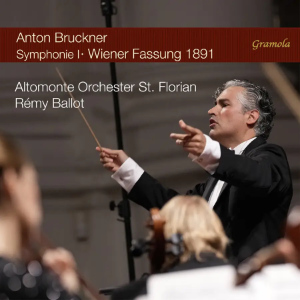
Anton Bruckner (1824-1896)
Symphony No. 1 in C Minor, WAB 101 (1891 Vienna Revision ed. Brosche)
Altomonte Orchestra Saint Florian/ Rémy Ballot
rec. live, 20 August 2022, Stiftsbasilika St Florian, Austria
Gramola 99283 SACD [64]
The issue of this last version of Bruckner’s First Symphony completes Rémy Ballot’s survey of ten Bruckner symphonies from “Die Nullte” through to the Ninth, which are now available collected into a box set. There have not been that many recordings of this version and most Brucknerians consider both it and the original 1866 versions inferior to the so-called “Linz” version of 1877, which has received the bulk of recordings. However, I enjoy Gerd Schaller’s live performance of this last revision and that has hitherto been my recommendation for those who wish to hear the best possible advocacy of Bruckner’s final thoughts and I refer you to my previous review of that for more background.
Ballot is typically spacious here compared with Schaller’s, Nelsons’ and Abbado’s Lucerne performances, as this comparison table of timings illustrates:
| Allegro | Adagio | Scherzo | Finale | Total | |
| Abbado | 12:04 | 12:44 | 8:40 | 16:40 | 50:00 |
| Schaller | 14:03 | 11:51 | 8:55 | 15:38 | 50:30 |
| Nelsons | 14:04 | 14:17 | 8:56 | 17:47 | 55:04 |
| Ballot | 15:48 | 16:23 | 10:19 | 21:20 | 63:53 |
Every movement in Ballot’s account is substantially slower than the others’, but obviously the biggest discrepancies are in the Adagio and the finale – and as Celibidache never tackled the First, we have no other recordings even approaching Ballot’s leisureliness; Andris Nelsons, playing this same, later version live with the Leipzig Gewandhaus Orchestra in 2020 (review), is the next slowest, still nine nearly minutes faster than Ballot.
However, in my estimation, Ballot has in the past got away with his daring tempi, as long as one accepts the premise in the same way as one approaches Celi’s Bruckner – and I have enjoyed every one of the issues in this series so far as something rather different but still valid. Whether this final instalment is a bridge too far regarding the stretching out of the pulse of this symphony will always be a very subjective question; for my part, I hear nothing indulgent or “draggy” about Ballot’s interpretation and the sonorousness of the orchestral playing, the way Ballot asks them to “play through” the notes, and the excellence of the recorded sound in that big acoustic all lend this performance great impact. The harshness of those opening repeated crotchets by the lower strings played at half the normal speed lends them and the ensuing jagged tune an eery menace, a threatening mood sustained into the brooding Adagio, which is four and a half minutes slower than Schaller’s, hence nowhere near as free-flowing but very grand and detailed. Special kudos is owed to the brass at the climax of the movement, building from around fourteen minutes in before the serene conclusion on sweetly soaring strings. However, I would certainly like to hear more bite and snap in the articulation of the fast outer sections of the Scherzo, which are nonetheless solidly and weightily executed but lack sufficient contrast with the more bucolic Trio. The finale is similarly large-scale and the five or six second reverberation, dying away slowly in the pauses, is rather effective. There is a relentlessness to its delivery here which is compelling, even if Ballot’s persistence with maintaining a steady beat lays the movement open to the accusation that it is five minute too long – and comparison with Schaller’s swifter, more propulsive way with the music rather confirms that suspicion. I cannot help feeling that at the climax around fifteen minutes in, it is time to wrap it up.
There is no extraneous noise and apart from the intervals between movements, where a little shuffling may be heard, this is indistinguishable from a studio recording, allowing for the spaciousness of the Stiftsbasilika.
Ralph Moore
Help us financially by purchasing from




















